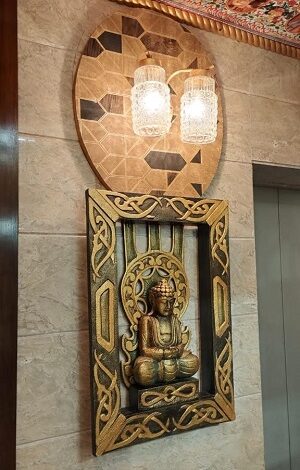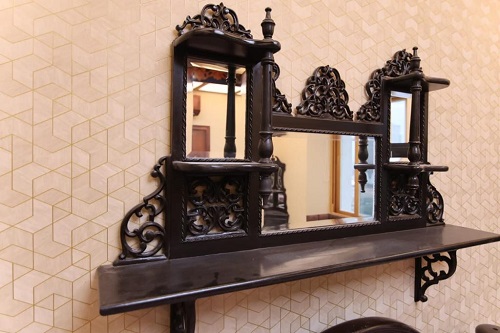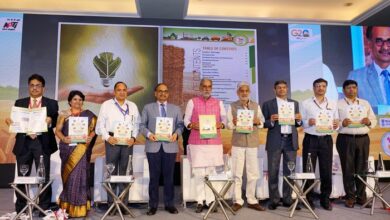
Reduce, Reuse, Recycle – A philosophy that we all need to follow to create a better sustainable world for the future generation. These 3Rs are probably the best known way to limit the waste products that end up in the landfill and reduce the carbon footprints.
Pradip Chopra, a businessman, philanthropist and educationist from Kolkata has implemented this philosophy both at his work and home. The 3Rs have been incredibly applied and executed at iLEAD, the higher education institution that he started back in 2010. Starting from the building to the interiors, iLEAD stands tall as a witness of successful sustainable design. Made mostly from used materials, the interiors of the college are a major attraction for visitors and students.
He not only confined the philosophy of 3Rs at iLEAD but also took it home. His home is a testimony of the fact that he is practicing exactly what he is preaching.
“The 3Rs namely reduce, reuse and recycle or upcycle form the base of waste management hierarchy that we need to implement in our lives in order to conserve natural resources and also save money and energy. Reducing helps us in scaling down the amount of trash that reaches the landfill. Reusing refers to innovating new ways to use a product instead of throwing it out. Recycling or upcycling refers to transforming an old thing to something new and useful. I have tried to implement this philosophy wherever possible or applicable while taking daily life decisions. And it’s kind of a feeling of victory for me now every time I turned something old into something brand new”, said Pradip Chopra.
It is actually astonishing to see the dumped items in the godown and then witness their makeover forms. While an average person may already reject the materials dumped in the warehouse, Mr. Chopra simply develops a new idea to transform that very discarded product into something phenomenal and useful. His fundamentals are simple – “Nothing is entirely disposable. We can re-engineer or design anything into something that you can use. You can call it repurposing the materials”.
The list of thrown away materials that he has repurposed is endless. Some of the most amazing repurposed materials are listed below.
Disposed blowers of air conditioners
His initiative to give iLEAD better indoor air quality needed more number of air filters. It could have been a fairly easy process to buy multiple air filters for the purpose. However, Mr. Chopra decided to repurpose disposed off blowers of old air conditioners.
The blowers are now re-engineered with UV lights that help not only to filter the air but also keep the indoors of iLEAD free from mosquitoes and insects. These remarkable AC blowers turned air filters already went through quality testing and are now used all over iLEAD.

Cracked toughened glasses that are discarded
Toughened or tempered glasses are almost 5 to 6 times harder than normal glasses. Even after a breakage they normally stay in place instead of getting shattered.
Cracked toughened glasses are also put into use by Pradip Chopra. Using transparent vinyl sheet, the cracked toughened glasses are fixed and now they can be found on the walls of iLEAD perfectly fitting the interior design of the space.
Dumped timber waste
The board made from timber waste is termed as ‘ghaas board’ by the local carpenters. In sophisticated English, it’s called particle board. The walls of Mr. Chopra’s home are adorned by these very particle boards.
Instead of using new wooden structures or plywood, he chose to use particle boards made from timber waste namely discarded wood chips, shavings and saw dust.
These boards are given absolute wooden finish by using sandpaper and oil based paint. They have added brilliance to the look of the interiors at his place.
Disposed cover of chocolate boxes from shops
The glass covers of the boxes that showcase chocolates in almost every grocery or general stores are also put to use by Mr. Chopra. They presently adorn the ceiling and walls of his home and iLEAD respectively.
The discarded covers of chocolate boxes are to be recycled/upcycled using new designs on transparent vinyl sheets. And then add up LED lights to it to get a bright and majestic false ceiling for your place.
Discarded plywood
Disposed plywood is also put to reuse by him quite ingeniously. Using canvas on the plywood, they are used as a part of the false ceiling at his house. The designs on the canvas enhance the beauty of the space.
Done away with mirrors and glasses
The mirrors or glasses that are rejected by people are also used to enhance the interiors at the Chopra household. Furnished with golden cut vinyl, they add to the grand decor of the living room in the house.

Old and discarded furniture
Abandoned furniture including bed, cupboards, sofa are also recycled/upcycled by Mr. Chopra. Using veneer (thin layer of wood used to give a finer finish), the old furniture are given an absolutely new and magnificent look. It’s impossible to identify the materials as old or obsolete.
Used plastic bottles that are thrown away
When we talk about urban gardening, vertical gardens dominate the discussions. At iLEAD, vertical gardens are found both at the outdoor and indoor zones of the campus.
Using disposed plastic bottles as containers of the soil and plants, the vertical gardens at iLEAD add to the air quality and beauty of the campus. Mr. Chopra has also included students in this initiative to raise awareness about vertical gardening that can be installed even within small and confined spaces of urban households.
Pradip Chopra’s efforts towards recycling had started 20 years ago. He was the first to start factory of plastic recycling in Falta Export Processing Zone, West Bengal. He developed a technology in collaboration with the Indian Jute Research Institute to recycle and upcycle multi-layer plastic scrap and plastic with paper such as tetra pack, which normally cannot be recycled by using conventional methods.
The ultimate product was called ‘Eco-Wud’ which was a superior alternative of wood and almost had infinite life. This product could be used in projects wherein indestructible materials were required to be used. For example – Exterior of buildings, foundations etc. Almost 150 various applications of eco-wud were devised following the innovation. This initiative aimed to protect trees and reduce the bulk of waste which was earlier not recycled and was going for landfill causing environmental hazard.
It was also used for preserving food grains by FCI. For this initiative, he received the prestigious Plasticon 2000 award from Plast India Foundation. Shri Ram Naik, the then Minister of Petroleum & Natural Gas, Government of India, had handed over the award to him.



